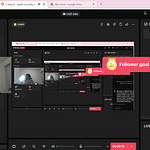Click for PPT Presentation
Main Takeaways
1. Understanding Power in Media
The presentation examined how power is represented and challenged through visuals, lyrics, and performance elements.
Key Moments of Power in the Show:
Opening Scene (0:00 - 0:45): Kendrick emerging from the 1980s Buick GNX symbolizes his rise from humble beginnings.
Uncle Sam Character (1:30 - 2:00): Samuel L. Jackson’s presence critiques government authority and societal expectations.
Divided American Flag Formation (2:15 - 2:45): Symbolizing national division and racial tension.
"GAME OVER" Display (5:00 - 5:30): Suggesting a call for systemic change.
Key Questions:
Who controls the message, and what narratives are being reinforced?
How does Kendrick use imagery to critique societal power structures?
Takeaway:
Lamar’s performance uses symbolism, historical references, and direct visual messaging to highlight systemic power struggles—challenging mainstream narratives while elevating Black voices.
2. Examining Access to Meaning
This lens focused on who can understand and engage with the message based on cultural, linguistic, and platform barriers.
Key Access Considerations in the Show:
Language and Lyrics (0:45 - 1:30): The depth of Lamar’s lyrics may limit comprehension for those unfamiliar with his references.
Cultural Symbols (2:00 - 2:15): References to Black history and resistance may be fully grasped only by certain audiences.
Platform Influence (Entire Performance): The Super Bowl brings Lamar’s message to a global audience, but how is it interpreted across different demographics?
Key Questions:
Does the performance speak to all audiences, or does it require cultural context?
How does the mainstream platform (Super Bowl) influence how the message is received?
Takeaway:
Lamar’s halftime show balances mainstream entertainment with deep cultural messaging, making it both widely accessible and deeply personal for those familiar with Black struggles. However, certain audiences may not fully grasp the depth of his critique due to cultural and historical references requiring prior knowledge.
3. Identifying Bias & Representation
Bias in media involves who is being portrayed, how they are represented, and what perspectives are prioritized.
Key Bias/Identity Considerations in the Show:
Portrayal of Authority (1:30 - 2:00): Uncle Sam character critiques government control.
Black Cultural Representation (2:00 - 2:15): The performance centers Black excellence through dance, music, and historical references.
Serena Williams’ Role (3:30 - 4:15): Challenges traditional gender roles within Black culture.
Addressing Stereotypes (2:15 - 2:45): Uses performance to subvert mainstream expectations of Black masculinity.
Key Questions:
Whose identities are being centered in this performance?
Does Kendrick resist or reinforce stereotypes?
How might different audiences interpret the show based on their own biases?
Takeaway:
The performance reclaims Black identity in a mainstream space, offering a nuanced portrayal that challenges stereotypes. However, different audiences may filter their understanding of Lamar’s message based on their own cultural background and biases.
4. Examining Diversity in Representation
Diversity analysis looks at whose voices are amplified and whose are missing.
Key Diversity Considerations in the Show:
Dancer Representation (0:30 - 1:00): Showcases various aspects of Black culture.
Musical Fusion (1:15 - 2:00): Incorporates different genres to highlight cultural influences.
Choreography (2:30 - 3:00): Draws from multiple dance traditions to tell a larger cultural story.
Audience Inclusion (3:45 - 4:15): Interactive elements invite participation.
Closing Message (5:00 - 5:30): Leaves room for diverse interpretations.
Key Questions:
Does the show represent multiple cultural perspectives, or is it focused on a singular narrative?
How does the performance use movement and sound to tell a diverse story?
Are any voices missing from this representation?
Takeaway:
Lamar’s halftime show celebrates Black culture while making room for broader interpretations—but it also raises questions about who gets to define and tell these stories in mainstream media. While it amplifies Black voices, there are limited representations of other marginalized communities within the performance.
Encouraging Students to Apply Critical Literacy Beyond This Show
The biggest takeaway from this presentation is that all media contains messages that shape public perception. Students should apply these four lenses to other forms of media—whether it be news, music, TV, or social media.
Steps for Further Analysis:
Choose a media text (music video, film, news article, social media post).
Apply the four lenses:
Who holds power in this narrative?
Who has access to this message?
What biases are present?
How diverse is the representation?
Discuss and Reflect: How do these elements shape the way you understand the message?
Final Reflection for Students
What was the biggest revelation from analyzing Kendrick Lamar’s halftime show?
How did applying critical literacy help you see the performance differently?
How can you use these tools to analyze other media in your daily life?
By using critical literacy, students become more engaged and aware consumers of media, able to question dominant narratives and recognize the power of storytelling in shaping societal beliefs.












Share this post